|
|
Post by Talira Greycrest on Jun 7, 2021 5:16:41 GMT
This small dino was discovered in the Gobi Desert: Name: AvimimusPronunciation: A-vee-my-musMeaning of name: "Bird mimic".Species: A. portentosus, A. nemegtensisSize: 1.5 metres long, 1 metre tall and weighing around 15kgs.Family: Avimimidae.Diet: Uncertain. Possibly either a herbivore, omnivore or insectivore.First fossils found: Known from at least seven specimens, the first of which was discovered by Russian palaeontologist, Sergei Mikhailovich Kurzanov, in Mongolia's Gobi Desert in 1981. A. portentosus named by Mr. Kurzanov in the same year. A. nemegtensis named by G. F. Funston in 2017.Lived: 85 to 70 million years ago during the Campanian and Maastrichtian stages of the Late Cretaceous in what is now southern Mongolia.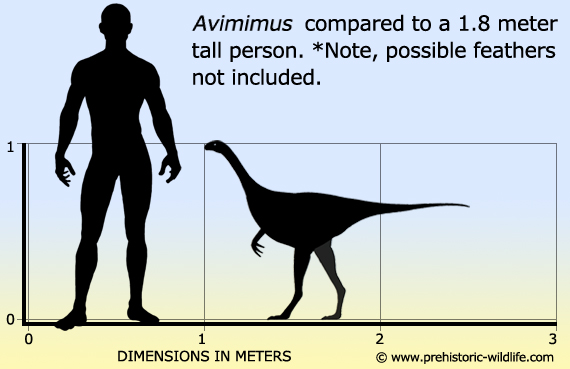 |
|
|
|
Post by Joey12 on Jun 7, 2021 5:36:49 GMT
Legs like a chicken I think.
|
|
|
|
Post by Joey12 on Jun 7, 2021 5:57:52 GMT
At the Field Museum in Chicago, IL. They have the T-Rex on a raised area. Probably to keep people from trying to touch it.  |
|
|
|
Post by Talira Greycrest on Jun 7, 2021 10:29:42 GMT
At the Field Museum in Chicago, IL. They have the T-Rex on a raised area. Probably to keep people from trying to touch it.  This is "Sue", one of the largest and most complete T-Rex specimens ever found. The skeleton is around 90% complete and was discovered by American explorer and fossil collector, Sue Hendrickson, in South Dakota in August 1990. In the years that followed, there was a legal dispute over ownership of the skeleton. After a lengthy civil case, the court awarded ownership to Maurice Williams, owner of the land where the fossils were discovered. "Sue" was put up for auction in October 1997, eventually being purchased by Chicago's Field Museum for US$8,362,500. On May 17th, 2000, "Sue" was finally put on display and now stands in her own gallery in the Evolving Planet exhibit hall. Unfortunately, we still don't know for certain if "Sue" is actually female. |
|
|
|
Post by Talira Greycrest on Jun 7, 2021 12:14:52 GMT
This dino had an ability that most dinos didn't have: it could chew its food. Name: CamptosaurusPronunciation: Camp-toe-sore-us.Meaning of name: "Bent lizard", in reference to the presumed flexibility of the sacral vertebrae.Species: C. dispar, though there may be at least two other species.Size: Estimated to have measured between 6 and 8 metres long, between 2 and 3 metres tall when standing upright and weighing around 2.5 metric tonnesFamily: Camptosauridae.Diet: Herbivore. Fed on both high and low-growing vegetation.First fossils found: Known from several specimens, the first of which was discovered by William Harlow Reed in Wyoming in September 1879. Was originally named Camptonotus by American palaeontologist, Othniel Charles Marsh, in the same year, but was re-named Camptosaurus because the original name had already been given to an insect.Lived: 166.1 to 157.3 million years ago during the Callovian stage of the Middle Jurassic through to the Oxfordian stage of the Late Jurassic in what is now the western and midwestern United States.
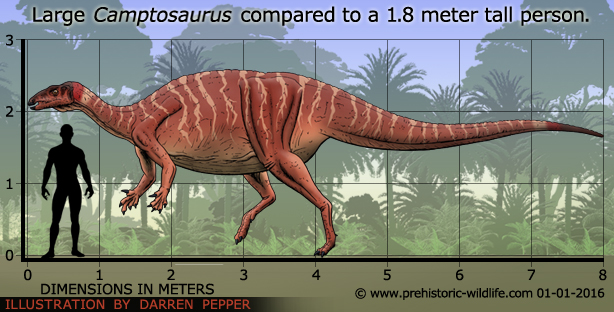 |
|
Tix Mascot
Tech guru
Italy is my second homeland
Posts: 11,071  Mini-Profile Background: {"image":"http://4.bp.blogspot.com/-X5mhw13BJ7Y/TwKeZ3uM7YI/AAAAAAAABPw/D82go4Ny_8E/s1600/italy-background-8-787281.jpg","color":""}
Mini-Profile Text Color: 0ef8f1
Mini-Profile Name Color: f40d39
Year of Birth: 1961
Nationality: Norwegian
Mini-Profile Background: {"image":"http://4.bp.blogspot.com/-X5mhw13BJ7Y/TwKeZ3uM7YI/AAAAAAAABPw/D82go4Ny_8E/s1600/italy-background-8-787281.jpg","color":""}
Mini-Profile Text Color: 0ef8f1
Mini-Profile Name Color: f40d39
Year of Birth: 1961
Nationality: Norwegian
|
Post by Tix Mascot on Jun 7, 2021 16:40:16 GMT
Legs like a chicken I think. That gives me association to how dinosaur meat could possibly taste. While living in Africa, I once tried crocodile, which was surprisingly good! Actually, it remided me of chicken, only tougher to chew. |
|
|
|
Post by Joey12 on Jun 7, 2021 23:02:59 GMT
Legs like a chicken I think. That gives me association to how dinosaur meat could possibly taste. While living in Africa, I once tried crocodile, which was surprisingly good! Actually, it remided me of chicken, only tougher to chew. I've heard that about crocodile also but have never tried it. Camptosaurus looks a little strange as it has small hind legs with what looks like more weight in front of the legs than behind the legs. |
|
|
|
Post by Talira Greycrest on Jun 8, 2021 1:27:14 GMT
That gives me association to how dinosaur meat could possibly taste. While living in Africa, I once tried crocodile, which was surprisingly good! Actually, it remided me of chicken, only tougher to chew. I've heard that about crocodile also but have never tried it. Camptosaurus looks a little strange as it has small hind legs with what looks like more weight in front of the legs than behind the legs. It probably spent most of its time walking on all-fours. |
|
|
|
Post by Talira Greycrest on Jun 8, 2021 2:09:03 GMT
This dino is one of the most numerous Asian ankylosaurs: Name: PinacosaurusPronunciation: Pin-ah-coe-sore-us.Meaning of name: "Plank lizard"Species: P. grangeri, P. mephistocephalusSize: 5 metres long, 1 metre high and weighing up to 2 metric tonnes.Family: Ankylosauridae.Diet: Herbivore. Fed on low-growing vegetation.First fossils found: Known from several individuals, including juveniles. First discovered by Walter Wallis Granger in Mongolia's Gobi Desert in 1923. P. grangeri named by American palaeontologist, Charles Whitney Gilmore, in 1933. P. mephistocephalus named by Belgian palaeontologist, Pascal Godefroit, in 1999.Lived: 80 to 75 million years ago during the Campanian stage of the Late Cretaceous in what is now southern Mongolia and northern China.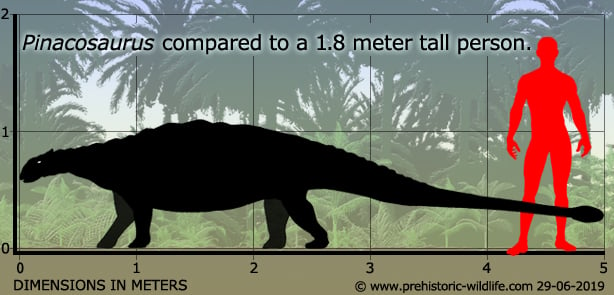 |
|
|
|
Post by Talira Greycrest on Jun 8, 2021 10:20:26 GMT
This animal is an Ammonite, a type of marine cephalopod: Name: ParapuzosiaPronunciation: Pah-rah-pu-zo-se-ahMeaning of name: "Near Puzosia".Species: P. seppenradensis, P. bradyi, P. daubreeiSize: Varies depending on species. P. seppenradensis, the largest species, is estimated to have had a shell diameter of between 2.5 and 3.5 metres, making it the largest-known Ammonite species.Family: Desmoceratidae.Diet: Carnivore.First fossils found: Known from many specimens discovered across Africa, Europe and the United States. P. daubreei named in 1894. P. seppenradensis named in 1895. P. bradyi named in 1946.Lived: 100.5 to 72.1 million years ago from the Cenomanian stage through to the Campanian stage of the Late Cretaceous in the warm oceans that once covered parts of what is now Africa, Europe and the United States.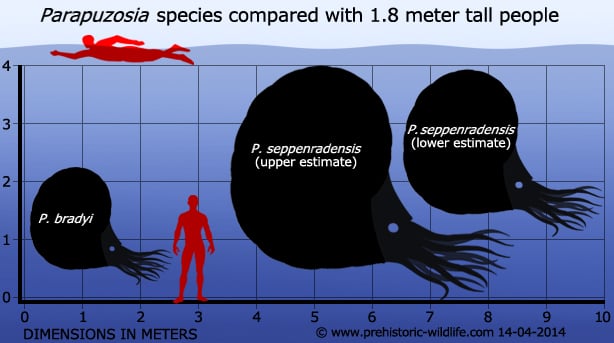 |
|
Tix Mascot
Tech guru
Italy is my second homeland
Posts: 11,071  Mini-Profile Background: {"image":"http://4.bp.blogspot.com/-X5mhw13BJ7Y/TwKeZ3uM7YI/AAAAAAAABPw/D82go4Ny_8E/s1600/italy-background-8-787281.jpg","color":""}
Mini-Profile Text Color: 0ef8f1
Mini-Profile Name Color: f40d39
Year of Birth: 1961
Nationality: Norwegian
Mini-Profile Background: {"image":"http://4.bp.blogspot.com/-X5mhw13BJ7Y/TwKeZ3uM7YI/AAAAAAAABPw/D82go4Ny_8E/s1600/italy-background-8-787281.jpg","color":""}
Mini-Profile Text Color: 0ef8f1
Mini-Profile Name Color: f40d39
Year of Birth: 1961
Nationality: Norwegian
|
Post by Tix Mascot on Jun 8, 2021 10:45:51 GMT
Could that possibly be an ancestor of modern octopus or jellyfish?
|
|
|
|
Post by Talira Greycrest on Jun 8, 2021 12:22:40 GMT
Could that possibly be an ancestor of modern octopus or jellyfish? Ammonites are closely related to modern squid, octopus and cuttlefish. Among my small fossil collection is a 165-million-year-old Dactylus ammonite. The first ammonites appeared during the Givetian stage of the Middle Devonian, 385 million years ago and existed right up until 66 million years ago, being wiped out along with pterosaurs, large marine reptiles and all the non-avian dinosaurs during the Cretaceous–Paleogene mass extinction event. |
|
|
|
Post by Talira Greycrest on Jun 8, 2021 13:35:24 GMT
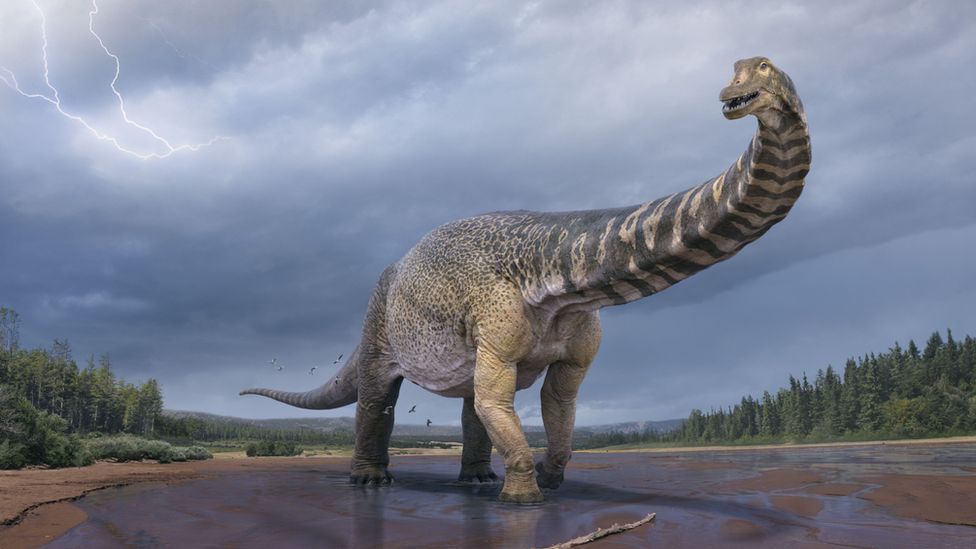 Say hello to Australotitan, officially Australia's largest dinosaur. |
|
|
|
Post by Talira Greycrest on Jun 9, 2021 2:37:37 GMT
This is a dino that we still don't know much about: Name: SegnosaurusPronunciation: Seg-no-sore-us.Meaning of name: "Slow lizard".Species: S. galbinensisSize: Estimated to have measured around 6 metres long, between 2 and 3 metres tall and weighing 1.3 metric tonnesFamily: Therizinosauridae.Diet: Unknown. Probably herbivorous.First fossils found: Known only from partial specimens, the first of which was discovered by a joint Soviet-Mongolian expedition in the Bayan Shireh Formation of Mongolia's Gobi Desert in 1973. Named by Mongolian palaeontologist, Altangerel Perle, in 1979.Lived: 102 to 86 million years ago from the Albian stage of the Early Cretaceous through to the Turonian stage of the Late Cretaceous in what is now southern Mongolia.
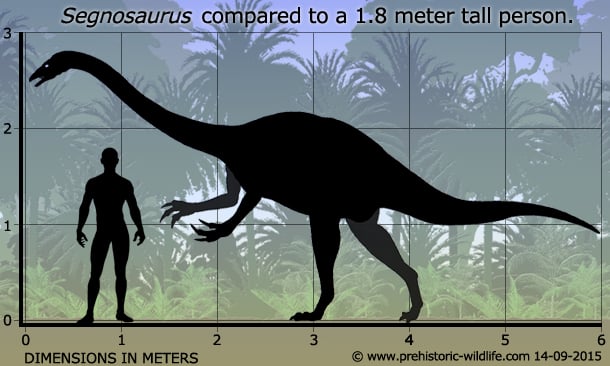 |
|
|
|
Post by Talira Greycrest on Jun 9, 2021 8:29:12 GMT
Name: VulcanodonPronunciation: Vul-can-o-don.Meaning of name: "Volcano tooth", a reference to the fact that it was discovered between two Jurassic-aged lava beds.Species: V. karibaensisSize: Estimated to have measured between 6 and 11 metres long, between 3 and 4 metres tall and weighed 3.5 metric tonnes.Family: Vulcanodontidae.Diet: Herbivore. Likely fed on both high and low-growing vegetation.First fossils found: Known only from a single, partial skeleton discovered in Zimbabwe, southern Africa, between 1969-1970. Named by palaeontologist, Michael Raath, in 1972. One of the earliest-known Sauropods.Lived: 201.3 to 199.3 million years ago during the Hettangian stage of the Early Jurassic in what is now southern Africa.
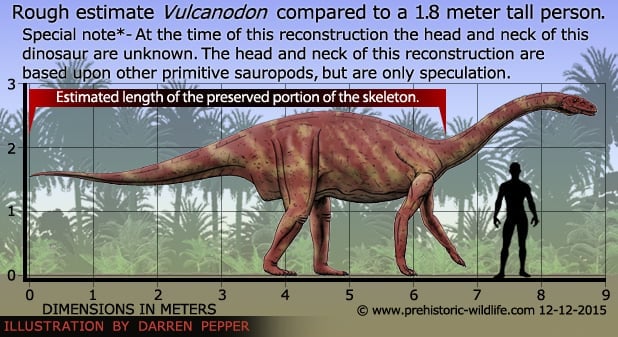
|
|